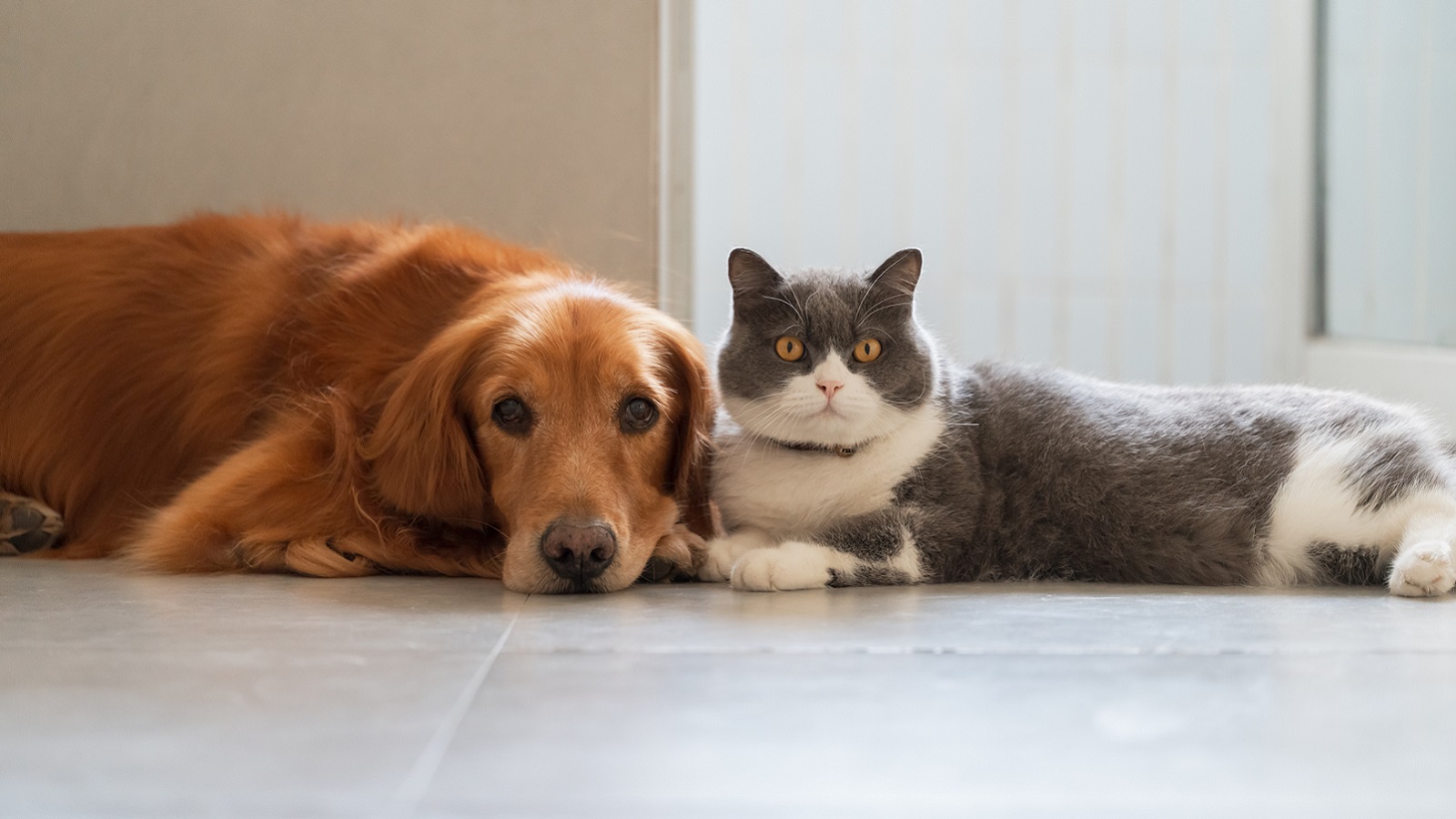Pet Ownership: What It Really Costs to Own a Dog or Cat
What's the true cost of pet ownership? Here's how much you should expect to pay when adopting a new furry friend.


If you’re considering pet ownership, whether for yourself or for your grandkids, it helps to be aware of all the costs associated with owning a pet. To help potential pet owners understand the financial responsibilities of owning a dog or cat, Rover has released its fifth iteration of the True Cost of Pet Parenthood. The report sheds insight into just how expensive it is to raise a pet, especially now that inflation has increased prices on many essentials.
In fact, Rover found that pet inflation is even outpacing other categories — 58% of pet parents say the cost of pet specific goods and services has increased more than the cost of other frequently purchased items. Those elevated costs will take a bite out of your budget. 30% of pet parents claimed they reduced spending in other areas of their life to make sure they can afford the items and services their pet needs.
Here’s a further look at just how much it actually costs to adopt and raise a dog or cat.
From just $107.88 $24.99 for Kiplinger Personal Finance
Become a smarter, better informed investor. Subscribe from just $107.88 $24.99, plus get up to 4 Special Issues

Sign up for Kiplinger’s Free Newsletters
Profit and prosper with the best of expert advice on investing, taxes, retirement, personal finance and more - straight to your e-mail.
Profit and prosper with the best of expert advice - straight to your e-mail.
What is the cost of owning a dog?
The annual cost of caring for a dog in 2024 ranges between $1,000 to $5,225 a year and $80 to $440 a month. This is a $100 increase from 2023. A major reason costs have risen is due to the spike in dog food prices, — which in some cases cost up to 80% more than last year — vet visits and treats and toys.
When budgeting for a dog, you’ll not only need to think about the cost of everyday essentials, like food and toys, but you'll also need to include any upfront costs associated with adopting an animal and any circumstantial expenses that may arise.
Here's a list of upfront expenses to plan for and their average cost, per Rover.
| Item | Average cost range |
|---|---|
| Adoption fees | $0 to $600 |
| Vaccinations | $167 to $515 |
| Spay or neutering | $250-$525 |
| Wellness exam and parasite prevention | $275-$435 |
| Collar/harness | $10-$140 |
| Leash | $5-$75 |
| Poop bags | $10-$90 |
| Food and water bowls | $5-$80 |
| Crate | $25-$475 |
| Bed | $10-$470 |
| Toys | $5-$220 |
| Treats | $2-$125 |
| Brush and nail trimmer | $15-$125 |
| Potty pads | $5-$70 |
| Cleaning supplies | $5-$55 |
| Food | $45-$345 |
Adoption fees can vary widely depending on where you adopt your dog. Shelter adoptions are usually cheaper and include several upfront costs like neutering, microchipping and initial vaccines. If you choose to purchase a dog from a breeder, you could pay anywhere from $500 to $4500 for the dog alone, depending on the breed.
Whether you need all the above items, like grooming supplies or puppy pads, really depends on the age, size and breed of dog you're getting. However, the total cost of bringing a new dog home typically ranges from $870 to $4,565 for the first year.
After the first year, you'll just need to budget for monthly essentials and any additional dog expenses you might need, like pet-sitting or grooming costs. On average, expect to spend anywhere from $1,000 to $5,225 per year on essentials, and between $1,405-$6,235 for additional costs (which you may or may not need) — several of which are listed below.
| Item | Average cost range |
|---|---|
| Food | $560-$4,115 |
| Flea and tick prevention | $225-$265 |
| Poop bags | $65-$85 |
| Treats and chews | $20-$380 |
| Toys | $5-$125 |
| Annual check up | $105-$130 |
| Annual Pet License Renewal | $20-$125 |
| Item | Average cost range |
|---|---|
| Emergency vet bills | $0-$2,985 |
| Dog boarding | $50 per night |
| Professional Grooming | $55-$195 |
| Apartment pet deposit | $150-$500 |
| Pet insurance | $10-$100 |
| Training | $55-$215 |
What is the cost of owning a cat?
Not a dog person? Overall, adopting a cat is cheaper than owning a dog, but maybe not as cheap as you think. Rover found that the annual cost of having a cat can range from $710-$2,865 a year, or between $60-$240 every month — an increase of $70 compared to 2023.
Here's a breakdown of what it costs to become a cat parent.
| Item | Average cost range |
|---|---|
| Adoption fees | $0-$185 |
| Spay or neutering | $165-$250 |
| Microchip | $20-$95 |
| Initial vet exam and vaccinations | $200-$390 |
| Collar | $5-$30 |
| Bed | $15-$250 |
| Food and treats | $40-$155 |
| Food/water bowls | $5-$90 |
| Litter box | $10-$550 |
| Litter | $10-$90 |
| Toys | $0-$80 |
| Claw trimmers | $5-$40 |
| Brush | $5-$50 |
| Scratching post | $20-$300 |
| Carrier | $20-$260 |
| Pet license | $15-$95 |
Once you've adopted your cat and have her settled, expect to pay about $710–$2865 per year. But additional expenses could also come up — like boarding costs, pet insurance and emergency vet bills — which add on average $2,080-$3,540. Here's a look at what you should expect to pay every year on essentials.
| Item | Average cost range |
|---|---|
| Food | $450-$1860 |
| Litter | $150-$720 |
| Toys | $5-$!55 |
| Annual vet appointment | $105-$155 |
Do you need pet insurance?
Luckily, there are plenty of ways to save money on pet costs. You don't have to shell out for top-notch food brands or expensive litter boxes to keep your pet happy. However, if you're looking to save money, there's one place where it's worth the extra expense — pet insurance. You may not think you'll need it — until you do — and then you'll be happy you had it.
In 2019, a study found that 45% of pet owners spend the same or more on their pet's healthcare than on their own. Sure, you could be handling your routine vet bills fine. But all it takes is for your dog or cat to get sick one time, and you're out several thousand dollars. For that alone, pet insurance is worth it. According to Rover, out of the 45% of dog parents who have pet insurance, 93% agree it’s worth the added cost. When it comes to cat owners, 36% have pet insurance, and 92% of them agree it’s worth it.
There are also several ways to save on pet insurance. As with all insurance policies, make sure to shop around and get several quotes, look for discounts and choose a higher deductible (as long as you can afford it). Also, if you insure your pets while they are younger, premiums will typically be less expensive.
According to the North American Pet Health Insurance Association (NAPHIA), these are the national annual premiums for pet insurance.
- Dog/Accident & Illness: $675.61 (monthly $56.30)
- Dog/Accident Only: $204.16 (monthly $17.01)
- Cat/Accident & Illness: $383.30 (monthly $31.94)
- Cat/Accident Only: $116.11 (monthly $9.68)
Related Content
Profit and prosper with the best of Kiplinger's advice on investing, taxes, retirement, personal finance and much more. Delivered daily. Enter your email in the box and click Sign Me Up.

Erin pairs personal experience with research and is passionate about sharing personal finance advice with others. Previously, she was a freelancer focusing on the credit card side of finance, but has branched out since then to cover other aspects of personal finance. Erin is well-versed in traditional media with reporting, interviewing and research, as well as using graphic design and video and audio storytelling to share with her readers.
-
 The SEC Is Concerned for Older Investors and Retirement Savers. Here's What You Should Know
The SEC Is Concerned for Older Investors and Retirement Savers. Here's What You Should KnowThe SEC focusing on older investors, retirement and college savers, and private securities. Here's how those changes impact you.
-
 Vesting, Catch-Ups and Roths: The 401(k) Knowledge Quiz
Vesting, Catch-Ups and Roths: The 401(k) Knowledge QuizQuiz Test your understanding of key 401(k) concepts with our quick quiz.
-
 Why You Should Pay Attention to Company Guidance
Why You Should Pay Attention to Company GuidanceUnderstanding how corporate profit forecasts affect analysts’ estimates and stock ratings can help you make investment decisions.
-
 How to Protect Yourself and Others From a Troubled Adult Child: A Lesson from Real Life
How to Protect Yourself and Others From a Troubled Adult Child: A Lesson from Real LifeThis case of a violent adult son whose parents are in denial is an example of the extreme risks some parents face if they neglect essential safety precautions.
-
 Here's How Much You Can Earn with a $100,000 Jumbo CD
Here's How Much You Can Earn with a $100,000 Jumbo CDYou might be surprised at how fast a jumbo CD helps you reach your goals.
-
 A Financial Planner Takes a Deep Dive Into How Charitable Trusts Benefit You and Your Favorite Charities
A Financial Planner Takes a Deep Dive Into How Charitable Trusts Benefit You and Your Favorite CharitiesThese dual-purpose tools let affluent families combine philanthropic goals with advanced tax planning to generate income, reduce estate taxes and preserve wealth.
-
 How Financial Advisers Can Best Help Widowed and Divorced Women
How Financial Advisers Can Best Help Widowed and Divorced WomenApproaching conversations with empathy and compassion is key to helping them find clarity and confidence and take control of their financial futures.
-
 Your Guide to Buying Art Online
Your Guide to Buying Art OnlineFrom virtual galleries to social media platforms, the internet offers plenty of places to shop for paintings, sculptures and other artwork without breaking the bank.
-
 I'm 59 With $1.7 Million Saved and Just Lost My Job. Should I Retire at 59½, or Find New Work?
I'm 59 With $1.7 Million Saved and Just Lost My Job. Should I Retire at 59½, or Find New Work?We asked professional wealth planners for advice.
-
 Metro by T-Mobile Is Giving Away This Samsung Galaxy A16: Which Plans Are Eligible?
Metro by T-Mobile Is Giving Away This Samsung Galaxy A16: Which Plans Are Eligible?Metro by T-Mobile is offering free Samsung Galaxy A16 phones on eligible plans right now. Here’s how the deal works.
-
 I Drive and Collect Classic Cars: Here’s How I Got in the Game Without Spending a Fortune
I Drive and Collect Classic Cars: Here’s How I Got in the Game Without Spending a FortuneAre classic cars a hobby or an investment strategy — or both? Either way, the vintage car scene is much cooler and more affordable than you think.